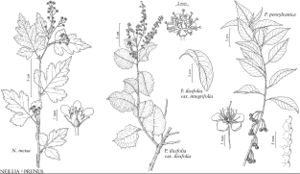Difference between revisions of "Neillia incisa"
Novon 16: 92. 2006.
FNA>Volume Importer |
imported>Volume Importer |
||
| (5 intermediate revisions by 2 users not shown) | |||
| Line 10: | Line 10: | ||
|special_status={{Treatment/ID/Special_status | |special_status={{Treatment/ID/Special_status | ||
|code=F | |code=F | ||
| − | |label= | + | |label=Illustrated |
}}{{Treatment/ID/Special_status | }}{{Treatment/ID/Special_status | ||
|code=I | |code=I | ||
|label=Introduced | |label=Introduced | ||
}} | }} | ||
| − | |basionyms={{Treatment/ID/ | + | |basionyms={{Treatment/ID/Basionym |
|name=Spiraea incisa | |name=Spiraea incisa | ||
|authority=Thunberg | |authority=Thunberg | ||
| + | |rank=species | ||
| + | |publication_title=in J. A. Murray, Syst. Veg. ed. | ||
| + | |publication_place=14, 472. 1784 | ||
}} | }} | ||
|synonyms={{Treatment/ID/Synonym | |synonyms={{Treatment/ID/Synonym | ||
|name=Stephanandra incisa | |name=Stephanandra incisa | ||
|authority=(Thunberg) Siebold & Zuccarini ex Zabel | |authority=(Thunberg) Siebold & Zuccarini ex Zabel | ||
| + | |rank=species | ||
}} | }} | ||
|hierarchy=Rosaceae;Rosaceae subfam. Amygdaloideae;Rosaceae tribe Neillieae;Neillia;Neillia incisa | |hierarchy=Rosaceae;Rosaceae subfam. Amygdaloideae;Rosaceae tribe Neillieae;Neillia;Neillia incisa | ||
| Line 37: | Line 41: | ||
|elevation=100–200 m | |elevation=100–200 m | ||
|distribution=Va.;Asia (Japan;Korea;Taiwan). | |distribution=Va.;Asia (Japan;Korea;Taiwan). | ||
| + | |introduced=true | ||
|discussion=<p><i>Neillia incisa</i> is commonly cultivated and is promoted in the nursery trade as an attractive, deer-resistant, and easy-to-grow ornamental shrub. The establishment and spread of <i>N. incisa</i> in Richmond, Virginia, shows its ability to naturalize and occupy shaded sites in moist temperate forests of eastern North America. Field observations indicate local spread by proliferous tip sprouting. Despite the paucity of documented occurrences of its naturalization, it can be expected to naturalize more broadly in eastern North America and may prove to be locally invasive. 'Crispa' is one of the more popular cultivars and is shorter in stature (less than 1 m) than the rest of the species.</p> | |discussion=<p><i>Neillia incisa</i> is commonly cultivated and is promoted in the nursery trade as an attractive, deer-resistant, and easy-to-grow ornamental shrub. The establishment and spread of <i>N. incisa</i> in Richmond, Virginia, shows its ability to naturalize and occupy shaded sites in moist temperate forests of eastern North America. Field observations indicate local spread by proliferous tip sprouting. Despite the paucity of documented occurrences of its naturalization, it can be expected to naturalize more broadly in eastern North America and may prove to be locally invasive. 'Crispa' is one of the more popular cultivars and is shorter in stature (less than 1 m) than the rest of the species.</p> | ||
|tables= | |tables= | ||
| Line 46: | Line 51: | ||
-->{{#Taxon: | -->{{#Taxon: | ||
name=Neillia incisa | name=Neillia incisa | ||
| − | |||
|authority=(Thunberg) S. H. Oh | |authority=(Thunberg) S. H. Oh | ||
|rank=species | |rank=species | ||
| Line 61: | Line 65: | ||
|publication title=Novon | |publication title=Novon | ||
|publication year=2006 | |publication year=2006 | ||
| − | |special status= | + | |special status=Illustrated;Introduced |
| − | |source xml=https:// | + | |source xml=https://bitbucket.org/aafc-mbb/fna-data-curation/src/2e0870ddd59836b60bcf96646a41e87ea5a5943a/coarse_grained_fna_xml/V9/V9_579.xml |
|subfamily=Rosaceae subfam. Amygdaloideae | |subfamily=Rosaceae subfam. Amygdaloideae | ||
|tribe=Rosaceae tribe Neillieae | |tribe=Rosaceae tribe Neillieae | ||
Latest revision as of 23:57, 5 November 2020
Leaves: stipules prominent. Inflorescences: peduncles glabrous to densely pubescent. Pedicels 5–8 mm, pubescent. Flowers: sepals distinct or basally connate. Follicles pilose. Seeds ovoid, shiny. 2n = 18 (Asia).
Phenology: Flowering May; fruiting Jul–Sep.
Habitat: Moist forests, forest edges
Elevation: 100–200 m
Distribution

Introduced; Va., Asia (Japan, Korea, Taiwan).
Discussion
Neillia incisa is commonly cultivated and is promoted in the nursery trade as an attractive, deer-resistant, and easy-to-grow ornamental shrub. The establishment and spread of N. incisa in Richmond, Virginia, shows its ability to naturalize and occupy shaded sites in moist temperate forests of eastern North America. Field observations indicate local spread by proliferous tip sprouting. Despite the paucity of documented occurrences of its naturalization, it can be expected to naturalize more broadly in eastern North America and may prove to be locally invasive. 'Crispa' is one of the more popular cultivars and is shorter in stature (less than 1 m) than the rest of the species.
Selected References
None.
